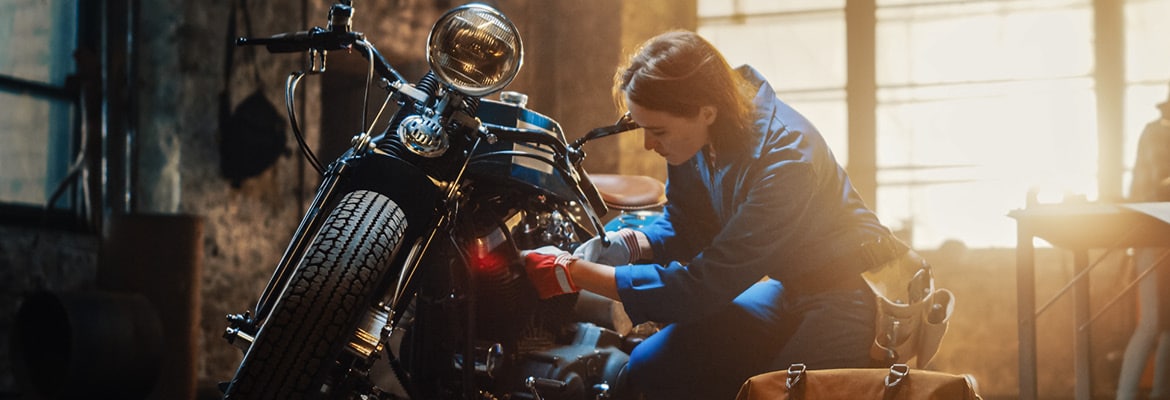Author(s)
While motorcyclists would love to ride year-round, those who live in colder climates may have the unfortunate task of motorcycle winterizing for storage during the winter months.
Winter riding adds an additional layer of risk, but that doesn’t mean you and your motorcycle can’t be prepared. Not only does riding at high speeds in cold weather require winter riding gear, the risk of a potential accident increases as well. Roads can be slick and slushy, and you have to keep your tire temperature up to operating manufacturer specifications, which can be a challenge in freezing temperatures.
Rather than simply leaving your bike as-is throughout the season, there are steps you can take to ensure it doesn’t incur any damage in storage during winter months. We have the information you need to keep your gas-powered motorcycle in optimal condition so you can hop right on and ride come spring.
How to winterize a motorcycle for storage
1. Change fluids if needed
Depending on where you live, your bike may need to be winterized. Only change your fluids if you notice a leak or you’re losing pressure. Otherwise, you should avoid draining the fluids as much as possible. If it’s only been a month or two and a couple of hundred miles since your last maintenance, there’s no need to do anything.
2. Wash, dry, and wax
There’s nothing better than taking your motorcycle out of storage at the beginning of riding season and seeing it sparkling clean! Washing, drying, and waxing the vehicle before putting it away also reduces the possibility of damage and erosion over the winter. Here’s the process we recommend:
- Start with the dirtiest parts (typically brakes): Start by lubing your chain and adjusting it within manufacturer specifications.
- Wash and dry the motorcycle exterior: Remove salt, dried-on bugs and other debris, then ensure the motorcycle is thoroughly dry to avoid trapping moisture that can cause corrosion or mold.
- Wax or treat paint and chrome: Applying wax treatment forms a barrier against moisture, rust, and other damaging elements.
- Treat leather: If you have leather seats or saddle bags, remove them from the bike to be treated and store them inside so they’re fresh for the next season.
As you clean, also inspect the various parts of your bike to identify any damage. If repairs are needed, address these right away. For more motorcycling detailing tips, refer to this 9-step guide.
3. Inspect your driveline
Treating your motorcycle’s chain before storing the vehicle can extend its life and protect it over winter. Follow all manufacturer procedures for lubricating the chain. If your motorcycle has a belt drive or a differential, you should inspect it as well and perform any maintenance needed based on the manufacturer’s specifications.
4. Treat the gas
Since you won’t be running your bike for at least a couple of months, you’ll want to treat the gas with a fuel stabilizer to ensure it remains viable once winter is over. If the fuel goes bad, it can ruin fuel system components. The recommended treatment process applies to fuel injection and carbureted bikes.
Fuel treatment process:
- Add fuel stabilizer
- Fill the gas tank
- Run the engine for a few minutes (this allows the stabilizer to move throughout all fuel injection components)
- Turn engine off
In both fuel injection systems and carbureted bikes, top off the tank to prevent moisture from building inside that can cause rust.
5. Prepare the exhaust
Once your exhaust is clean, coat the outside of the system very lightly with WD-40. This is done to prevent damage to any chrome components. Lastly, insert a plastic bag into the pipe, wrap the excess around the outside, and secure it with a rubber band. You’d be surprised how many pests seek shelter in these pipes during winter!
6. Maintain the battery
Perhaps one of the more important steps to winterizing your motorcycle is checking the battery. While leaving it in place doesn’t generally harm your bike, the battery will likely deplete and need to be replaced come spring. Removing the battery and hooking it up to a battery tender or trickle charger will ensure that it will be properly stored during those cold months.
7. Check tires
It’s wise to inspect tires for wear and aging. If the tread has deteriorated, plan to invest in a new set before spring. Due to seasonal temperature drops, it is recommended that your motorcycle tires are raised off the ground to reduce the possibility of flat spotting them. There are several ways to do so, either by specially designed stands for your make and model, a motorcycle jack, or by getting safely creative.
8. Don’t forget your gear
You’ll also be storing your clothing and other riding gear for the next few months, so it only makes sense to get them in tip-top shape:
- Clean and condition leather pieces (jackets, pants, gloves)
- Brush and oil leather riding boots
- Clean the helmet’s inner liner and wipe down the outside. Most helmet manufacturers design their liners to be removed and are washing machine safe.
Watch for more detailed instructions: How to Winterize Your Motorcycle | MC Garage
If your motorcycle has reached the end of its life or you plan on purchasing a new bike next season, consider donating it to charity.
Methods for motorcycle storage in the winter
Everything has been cleaned and treated as necessary—now it’s time to get your bike to its resting place for the season. Here are a few tips.
Lock down the best location
Ideally, you’d have a storage unit or self-storage spot in your garage or shed specifically to keep your bike, but not everyone has the funds or space to do so. In some cases, bike owners may ship their motorcycles to another location for winter. Wherever you choose to store the vehicle, ensure it is covered and dry. Moisture accumulation can lead to several issues including rust and mold formation.
Invest in a cover
Even if your motorcycle is stored in a sheltered place, a cover can add further protection. You can use a tarp or a sheet, but those specially made for motorcycles are the most effective: they are breathable and keep both water and UV light off the bike’s surfaces.
Elevate the motorcycle
When your tires are in the same position for an extended period of time, it can create flat spots that affect how the bike drives. Storing the bike elevated, either via the center stand or a hydraulic lift, removes pressure on the bearings and bushing and prevents damage. If this isn’t possible, roll your vehicle once every few weeks to prevent flat spots on the tires.
Help with motorcycle winter storage
Need to transport your bike to store it for the winter? Montway Auto Transport ships thousands of motorcycles, cars, trucks, ATVs, and other vehicles across the country every month. If you’re a motorcycle owner and want more information, check out our motorcycle shipping services or call us at 888-989-8526 to get a free custom quote.








